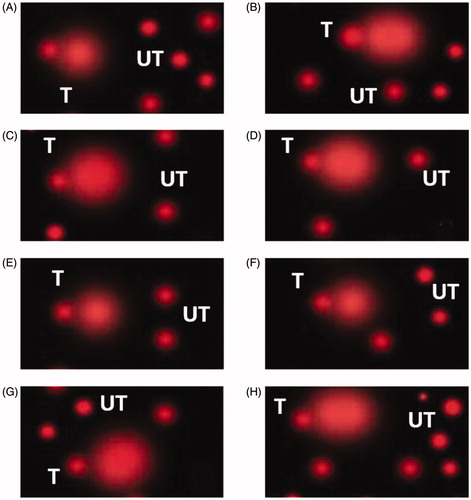Figures & data
Table 1. Hepatic inflammatory cytokines levels and acute phase protein concentration for New Zealand White and Baladi Black rabbits are exposed to early acute heat stress at weeks 5 and 13 of age.
Table 2. Hepatic lipid peroxidation and antioxidant enzymes levels for New Zealand White and Baladi Black rabbit exposed to acute heat stress at weeks 5 and 13 of age.
Figure 1. Evaluation of DNA damage in the rabbit's hepatic cells using the comet assay. The photos show the electrophoretic DNA pattern as tailed (T) and untailed (UT) DNA. (A) New Zealand white control at five-week, NZWC (B) NZWT New Zealand white exposed to early acute heat-stress at five-week, (C) Baladi Black control at five-week BBC, (D) BBT Baladi Black exposed to early acute heat-stress at five-week, (E) NZWC2 New Zealand white control exposed to heat stress at 13 weeks (single exposure), (F) NZWT2 New Zealand white exposed for the second time to heat stress at 13 weeks (Double exposure), (G) BBC2 Baladi Black control exposed to heat stress at 13 weeks(single exposure) and (H) BBT2 Baladi Black exposed for the second time to heat stress at 13 weeks (Double exposure). At week 5 of age, only heat stress exposed groups were subjected to acute heat stress (36 °C 62% RH for 6h). At week 13 of age, all the experimental rabbit groups were subjected to acute heat stress (36 °C 62% RH for 6h).

Table 3. DNA damage measured using Comet assay for New Zealand White and Baladi Black rabbit exposed to acute heat stress at weeks 5 and 13 of age.
